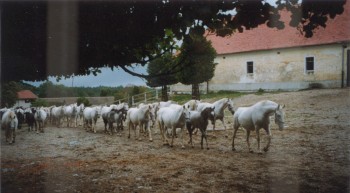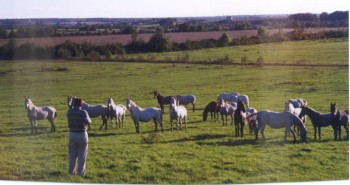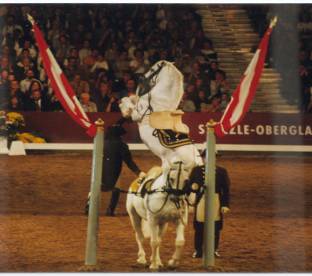 |
 |
3275 Stonyvale Road Tujunga, CA 91042 Phone/Fax: (818) 353-1616 |
|
History of the Lipizzan breed
The Lipizzan horse is one of the oldest breeds of horses in Europe. The original breeding farm, Lipica, was created in the year 1580 in what was at that time part of the Austrian Empire (now in present times the country of Slovenia). The foundation for the Lipizzan breed were the horses from the Karst mountain regions. Horses were selectively bred on this mountainous plateau above the city of Trieste already during Roman times. This mountainous area was very suitable for developing the desired traits of strength and hardness. The Karst horses were known for their quiet and good temperaments. These horses were highly sought after during medieval times for tournaments as well as war horses. Their endurance and longevity was described as highly regarded traits in the literature from that time period. The Neapolitaner horses, an Italian breed developed by using Arabians stallions on the heavier native mares, were also highly regarded during this time period. They were larger and much heavier than the Spanish horses and the Arabians. This breed had its highest popularity during the 1600 hundreds and the horses where famous for combining size with grace, quiet temperament combined with their high-stepping trots and slow walk with high knee extensions. At that time it was regarded as the most suitable breed for high school and as parade horse at the Imperial Courts. Through attrition during wars, faulty breeding programs, bringing to much foreign blood in, the breed declined steadily during the 1700´s and finally became extinct. The Spanish horses including the Andalusian, originating from Arabians and Berber horses from North Africa, were brought to Spain in the 8th century. These Spanish horses had a large influence on the Lipizzan breed throughout its history. The convex nose, still common among the Lipizzaners and Andalusians has been inherited from the Berber horse. During the 15th and 16th century these majestic horses, with their long manes and high stepping gaits became the status symbol of the royal courts throughout Europe. Most of the Arabians influence on the Lipizzan breed originated through the Spanish horses. However during later years, purebred Arabian stallions were used to bring endurance and refinement into the breed. As the importation of horses from the Spanish Peninsula became more difficult, the Vienna court under Archduke Karl II decided to develop their own breeding farm. In the year 1580 a representative from the court traveled to Spain bringing back three stallions and over the next couple of years an additional 6 stallions and 24 mares were brought back to Lipica. The original horses from this region, with the Spanish horses became the foundation of the Lipizzan breed. During the time of Maria Theresa (1740-1780) there were 150 broad mares at the breeding farm. Of the classical stallion lines that we know today, in the early days of the breed, the originators were as follows: the grey Pluto from Fredriksborg in Denmark where they had bred old Spanish and italien horses since 1562. Pluto was born in 1765 and brought to Lipica in 1772. He was followed in 1774 by the dark brown Conversano, born in 1767, an original Neapolitaner. The grey stallion Maestoso was born in 1773 and the Royal breeding farm at Kladrub in Bohemia. The stallion Favory, was also from Kladrub, born in 1779 and the bay Neapolitano born 1790, was a representative of the original old Italian Neapolitaner breed. The Arabian Siglavy, born in 1810 and introduced in 1816, was the most successful of all the Arabian blood introduced to the breed. Later on, two more stallion lines were introduced, Incitato from Hungary and Tulipan from Croatia. In addition, in Lipica, great importance was given to the mares and eighteen classical mare lines that originated there. Various breeds were represented, Karst, Kladruber and Arabians, most of these lines continuing on through today. The wars in Europe created difficulties for the Lipizzaners throughout the centuries starting with the Napoleonic wars in 1796, when the breeding farm and all the horses were evacuated to Hungary, a 6 week long journey. During this trip 16 foals were born who all survived to return to Lipica. This return occurred in September 1798, however all the facilities at the farm had been destroyed. In 1805 another war broke out between France and Austria and again the horses were evacuated from Lipica, this time to Dakovo. During this winter flight and during the stay at Dakovo the horses were exposed to severe hardships and on their return to Lipica in 1807, only one foal was born. Two years later the horses were again evacuated, as the Karst region had been seceded to France. This time 289 horses were evacuated to the town of Petska in Hungary, where they stayed for 6 years before they returned to Lipica. This period was not very productive, as the climate was very different from the Karst region and the Lipizzan horses did not do very well there. After this return a long period of peace returned and it was during this period that experimentations with including Arabians, thoroughbreds and other breeds into the Lipizzan breed, were conducted. It became apparent fairly soon, that most of this experiments did not improve the breed and they were eventually abandoned. The Arabians were removed from Lipica by 1885. During this last time period, important contributions to the breed were made from other breeding farms, both state owned and private, established within the Austro-Hungarian Empire. Lipica made stallions available to these breeding farms and it was also during this time that the other two stallion lines, Incitato and Tulipan, were established. In May 1915, war again broke out and Lipica had to be evacuated. The stallions, broadmares and the trained horses were moved to Laxenburg near Vienna, while the younger horses were transferred to Kladrub in Bohemia, in what is now the Czech Republic. At the end of the first World War, the Karst region was seceded to Italy, however Austria did not wish to give up all the Lipizzaners and a compromise agreement was established. Austria retained 97 horses and 107 were transferred to Italy. The horses which were assigned to Hungary were purchased by the Hungarian Count Esterhazy and the young horses that had been sent to Kladrub, remained there and became the foundation for the stud farm at Topolcianky. The Yugoslavian Government, to start a breeding farm at Stancic, purchased several of these original Lipica horses. As a result of this break-up of the horses, Lipica lost the right to its original designation of "Imperial and Royal Court Breeding Farm Lipica" which it had held for 339 years. By 1930, only 30 mares were remaining at Lipica and two stallions from Stancic were bought to revitalize the breeding program, and in 1940 they had increased to 52 mares. When Italy capitulated in the second World War, 179 of the horses were moved to Hostau in Czechoslovakia, where in addition to the horses from Lipica, the Lipizzaners from Piber and Demir Kapija had been sent. At the end of the war, Lipica now belonged to Slovenia, but after long negotiations, they were only given back 11 of their horses, 1 Siglavy stallion, 3 broad mares and 7 young horses. The remainder of the horses were divided between Italy and Austria, and some time later they received an additional 24 horses. At the end of 1950, the breeding farm was up to 180 horses, however hard economic times and a desire to return the breed to its original quality, caused hardships. Stallions were brought from Piber and the other studfarms and after a long period and severe culling, Lipica now is back to breeding to original type of quality Lipizzan horses. In the 1980´s, Lipica owned horses were very successful in dressage competitions, culminating with sending a team to the Los Angeles Olympic Games.
During the years many stud farms had been established within the old Austrian-Hungarian empire. In the former Yugoslavia several breeding farms, which are no longer in existence were established: Stancic (1920-36), Demir Kapija (1924-41), Lipik (1937-56 ) and Kutjevo (1946-60). Dakovo, in Croatia, is regarded as one of the oldest breeding farms in Europe, having been established in 1506, originally to breed oriental or Arabian horses. In 1806 the Lipica horses were housed there and they started a small scale breeding program. In 1854, Dakovo purchased more horses from Lipica and converted to only breeding Lipizzan horses.
Lipik , also in Croatia was reestablished in 1982 with breeding horses from Lipica. The breeding farm was totally destroyed in 1991 from bombing during the recent Yugoslavian civil unrest and 35 horses were killed. Vucijak, in Bosnia Herzegovina, was originally established to provide stallions for the farmers and many of the horses are solid in color. This breeding also fell on hard time during the unrest in the region, and an international effort, with large contributions from the USA, was established to rescue and feed the horses. This appears to have been successful and the horses are in good condition. Karadordevo in Serbien was established in 1903, however they started to breed Lipizzaners in 1946 with horses from Dakovo and Lipica. Not much is known about the studfarm today. The breeding farm in Piber was established in 1798 for the purpose of providing horses to the military and the farmers.. The year 1853 a Lipizzan breeding program was started. This program was however transferred to Radautz (in present Romania) in 1869, as the main purpose of Piber was to breed part bred horses for the cavalry. Piber, as we know it today, was reestablished in 1920 as the main breeding center for Lipizzaners in Austria. During the second World War and the German occupation, the horses were again moved and this time they were transported to Hostau in Bohemia. The Lipizzaners were brought back to Austria and Hostau in 1945, mainly through the efforts of the American General Patton. It was however not until 1952, that all of them were returned to Piber. The breeding program started with these mares and an additional 10 mares from the stud farm Vukovar, a total of 40 mares, and three stallions from the Spanish Riding School. The goal at Piber is to provide a proud baroque stallion, similar to the original horse from Lipica, destined for the Spanish Riding School in Vienna. For this reason, only the six classical stallion lines are used. Only the best performance stallions are returned to Piber to assure the continuation of the classical Lipizzan. The Lipizzan breeding in Hungary started in Mezohegyes after the 6 years stay of the horses from Lipica between 1809 and 1815. After the return of the horses, a few remaind, and became the nucleus of the Hungarian breeding program. Mezoheges was originally started in 1785 and eventually became the biggest breeding farm in Europe, containing between 4-5000 horses. In the year 1874 all of the 137 Lipizzaners were moved to Fogaras, where they remained until 1912, when they were moved to Babolna. At this time, the Lipizzaner was mainly bred to be a working horse for the farmers and Babolna became the mecca for the breeding of Arabian horses in Europe. During the second World War, the horses were scattered and many were relocated in the southern German state of Bayern. During this period, in Hungary, as in most of the other European countries, the Lipizzan could not remain a "luxury horse" and was used extensively for cross breeding as well as working at the farms. After the war, 20 mares and 3 stallions were returned to Hungary and became the foundation of the new breeding program. Eventually the young stallions had been sent to the old breeding farm of Count Pallavicini in Szilvascarad, for pasture and eventually, as Babolna became devoted to Arabian horses, all of the Lipizzaners were moved to Szilvasvarad, where they still remain. Simbata de Jos in Romania was established in 1874 to accommodate the horses from Mezohegyes in Hungary, which had turned out to be unsuitable for horse breeding. The first shipment was 137 horses of which 5 stallion, 49 mares and 35 foals were Lipizzaners. Mares were brought from Piber and within 20 years there were 9 stallions and 110 broad mares at Fogaras. In the year 1912 most of the horses were transferred to Babolna in Hungary. The three stallions and 22 mares, who were left as working horses eventually, in addition to locally purchased horses, became the foundation of the Simbata de Jos/Fogaras stud farm in 1922. At Fogaras, as well as at small prtivate breeding farms, a large breeding program exists for solid colored Lipizzaners, black, bay and chestnuts. Beclean, another breeding farm in Romania, today breeds exclusively chestnut Lipizzaners. Topolcianky, in Slovakia, was founded by the Czechoslovakian government in 1921, where in addition to Lipizzaner there is extensive breeding programs for Arabians, Shagya, Hutus (ponies) and thoroughbreds. Thirty mares, born during the Lipica herds residence at Topolcianky during 1915 and 1916, remained to become the foundation together with one Lipica and two Fogaras stallions. During the second World War, the horses from Topolcianky, as with the other breeding farms, were scattered. They were able to repurchase between 70-80 of the horses after the war. Topolcianky is breeding a heavier Lipizzan, suitable for driving and farm work, however still maintaining the classical type. The present Lipizzan breeding farm in Italy is Monterotondo. After the first World War, half of the horses from Lipica were given to Austria and the remainder to Italy, in addition to all of the original stud books. The 109 horses, representing the six classical stallion lines and seventeen mare lines, remained at Lipica, which now became a breeding farm for the military and the goals changed. Very large Lipizzan stallions were used, some with Kladruber bloodlines as well as mares with Kladruber background were purchased and larger, heavier horse was developed. On the last day of the second World War, the German army invaded Lipica and removed all 179 horses to Hostau. After the war, half of these horses were returned. The breeding farm is now located 35 kilometers from Rome where Monterotondo is located. All of the early breeding records and studbooks from Lipica are located at Monterotondo. The Spanish Riding School in Vienna exemplifies to all of us the beauty and uniqueness of the Lipizzan horse. This institution has made the name Lipizzan a name known the world over. The "Spanische Reithall" was first mentioned in 1572. It was housed in a wooden building and received its name from the Spanish horses that were trained there. The existing location was built 1735 and was used extensively for celebrations with riders and carriages, especially during the time of Maria Theresa. I 1916, when Emperor Franz Joseph died, the Spanish Riding school lost its last Imperial sponsor. The school did however survive, and later during the second World War, the German supported it. During this time period, in 1942, all the Lipizzan breeding stock were sent to Hostau. The return of the Lipizzaners to Austria was made possible by the intervention of General Patton, and this has been well described in the Walt Disney movie "The Miracle of the White Stallions" starring Robert Taylor. The Spanish Riding School is today more popular than ever tickets for their performances are highly sought after.. Occasionally the stallions go on tours throughout the world and have visited the United States twice.
|
Lipizzan Connection
Barbara Gjerset Ingun Littorin
3275 Stonyvale Road,
Tujunga, CA 91042
Phone/Fax: (818) 353-1616
Email the Lipizzan Connection


